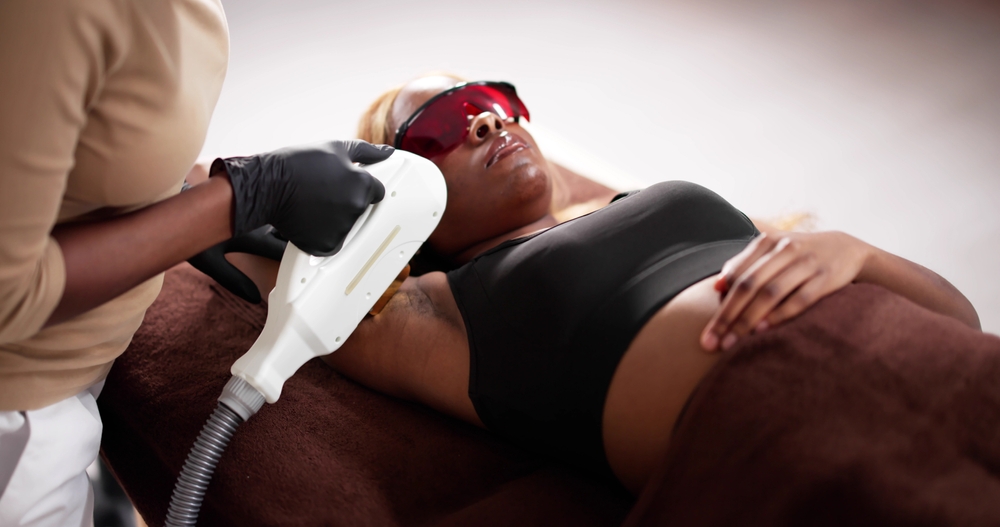Are you tired of shaving each morning, just to do it again the next day? Do you struggle with ingrown hairs?
Would you like to achieve smooth, hair-free skin without the pain and irritation of waxing?
If you answered yes, laser hair removal can offer a safe, effective, and long-lasting solution!
Continue reading to learn all about laser hair removal, including how it works; what to expect from treatment; benefits; anticipated results; and longevity of outcomes.
What Is Laser Hair Removal?
Laser hair removal is a noninvasive procedure designed to eliminate unwanted hair from the face and body. It is performed in an office setting, is virtually painless, and requires zero downtime.
Best of all, laser hair removal can achieve significant hair reduction in the treatment area with permanent results.
That means patients can eventually stop shaving, waxing, plucking, or trimming.
How Does Laser Hair Removal Work?
During a laser hair removal treatment, concentrated beams of light are delivered via a hand-held device.
This light-based energy bypasses skin and is absorbed by melanin in the hair follicle.
At this point, energy is converted to heat, which damages the growth center in the hair follicle and prevents regrowth.
What Can Patients Expect From the Procedure?
By all accounts, laser hair removal is a quick, convenient, and comfortable experience.
The process begins with a consultation to discuss the treatment benefits, contraindications, pre-and-post-care instructions, and the number of sessions you may need.
At this initial meeting, you will be advised to shave the intended treatment area(s) the day before your appointment.
This is done to ensure that the laser energy has a clear pathway to target hair follicles. You should also avoid waxing, plucking, and sun exposure for four weeks prior.
When you arrive for your LHR appointment, you will complete any necessary paperwork and will be shown to an exam room.
Your provider will go over any additional concerns you may have and then ask you to change into a gown and put on the protective eye wear.
Once you have changed and the technician returns to the room, she will begin the laser hair removal procedure by placing a cool gel on the treatment area.
Then, the laser hand piece will gently glide across your skin, delivering a series of pulses.
Newer technologies usually come equipped with a cool-tip that prevents skin from getting too hot and significantly improves comfort and safety.
As a result, patients find laser hair removal to feel similar to a hot stone massage, with an occasional sensation of a rubber band snapping against the skin.
Most areas can be completed in 10-20 minutes. Treatment time will vary depending on the size, location, and number of body parts.
At the end of the procedure, you will be provided an ice pack, if needed, and cleansing wipes to remove any gel.
Before leaving the office, you should schedule another treatment in six-to-eight weeks.
What Are the Pros of Laser Hair Removal?
There are a number of benefits to laser hair removal that make it an excellent alternative to shaving, waxing, plucking, and trimming.
To start, LHR can significantly reduce hair growth (by up to 80-90 percent) on virtually any part of the face or body, making it much easier to achieve consistently smooth skin.
Additionally, the procedure can eliminate unsightly and painful ingrowns that many women and men experience with shaving and waxing.
It also provides long-lasting results and is far less painful or time-consuming than other hair removal options.
Are There Any LHR Disadvantages to Be Aware Of?
There aren’t any disadvantages to laser hair removal per se. Rather, there are factors that patients should be aware of before starting treatment. Such as the time commitment.
Because the laser can only act on follicles in the active growth phase, patients will need to undergo a series of LHR sessions, spaced six-to-eight weeks apart. And consistency is key in order to produce optimal outcomes.
It’s also important to note that laser hair removal can be costly, at least initially.
However, the money and time that patients will save, on waxing, razors, shaving cream, etc., in the long-run makes LHR a worthwhile investment.
Finally, anyone considering laser hair removal should take care to seek a highly skilled and qualified provider.
In the hands of an inexperienced practitioner, LHR can be extremely dangerous and result in burns, blisters, hyperpigmentation, hypopigmentation, and scarring.
Do Men Get Laser Hair Removal?
Yes! Men most definitely get laser hair removal.
Like their female counterparts, many guys are tired of shaving their faces every day or feel self-conscious about excess body hair.
Laser hair removal for men offers a safe, effective, and fast way to address these issues and improve the way you look and feel.
Popular Treatment Areas for Men

Men often choose to have laser hair removal to enhance their appearance, eliminate the inconvenience of shaving, eradicate cumbersome ingrowns, and reduce hair-induced irritation.
Accordingly, popular treatment areas for guys include the face, neck, chest, abdomen, shoulders, and back.
How Many Treatments Are Needed?
Depending on hair density and coarseness, most patients benefit from a series of six-to-eight laser hair removal treatments, scheduled six-to-eight weeks apart.
When Can Patients See LHR Results? How Long Do Results Last?
Although laser hair removal results aren’t instant, patients will be pleased to note hair falling out in seven-to-10 days.
In the coming weeks, they will also find that regrowth is slower and finer and that they have to shave less frequently.
These effects improve with each LHR treatment and are permanent. However, most patients undergo annual maintenance treatments to best preserve their results.
Get Started with Laser Hair Removal Today
If you are considering laser hair removal, please call our office today to schedule a consultation with one of our highly skilled and experienced providers.




